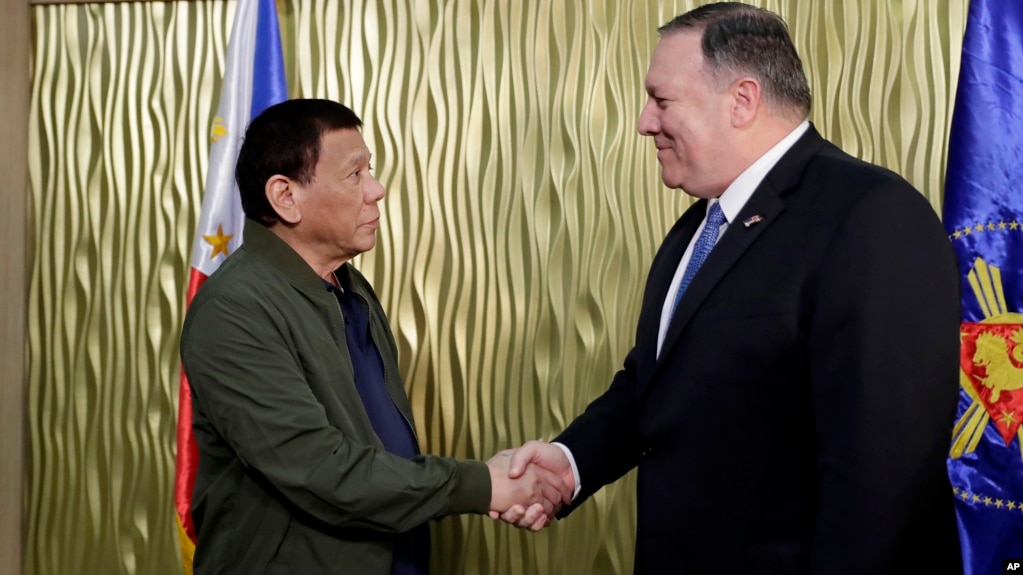
The Philippines is edging further back into a once strained alliance with the United States as China, a friend of three years, keeps challenging Manila’s maritime claims and offers less aid than many Filipinos had hoped.
Philippine-U.S. cooperation has picked up over the past two months with U.S. Secretary of State Mike Pompeo’s visit to Manila followed by a wide-reaching series of joint naval exercises.
President Rodrigo Duterte of the Philippines sidelined his country’s U.S. alliance after taking office in 2016 to seek peace with China. Since then China has alarmed Manila’s military as well as citizens by sending flotillas near a tiny Philippine-held island in a sea that they dispute and harassing Filipino fishermen near another islet.
“Every time one of these incidents happens, he faces an enormous domestic backlash and a whole bunch of criticism that he’s being played for a fool by Beijing,” said Gregory Poling, director of the Asia Maritime Transparency Initiative under Washington, D.C.-based think tank Center for Strategic and International Studies.
A swing back to the United States would position the Philippines where it was geopolitically before Duterte took office -- one in a chain of U.S. Western Pacific allies – and put China on the defensive against growing U.S. influence in Asia.
Firmer US ties
Pompeo visited March 1 to “reaffirm U.S. support for this critical treaty ally,” the State Department said. Pompeo said on the ground that his government would back the Philippines militarily if China attacked its vessels or planes in the South China Sea, domestic news outlet Rappler.com said.
Coinciding with the visit, Philippine Foreign Secretary Teodoro Locsin expressed opposition to reviewing the Mutual Defense Treaty with the United States – a process that could overturn the 68-year-old document.
During annual joint military exercises April 1-12, the U.S. Navy sent its USS Wasp amphibious assault ship and F-35B Lightning II aircraft operated by the U.S. Marines, Washington’s Indo-Pacific Command said. The Wasp was the largest U.S. ship ever sent for the exercises.
The vessels simulated defense of the South China Sea, an exercise that Philippine President Rodrigo Duterte cut in 2017 while he was building ties with Beijing.
Duterte set aside the Sino-Philippine sovereignty dispute and began talks with China in 2016. Duterte’s vociferous rejection of U.S. help at the time enchanted China, which has viewed Washington with suspicion since the Cold War.
China disappoints
China and the Philippines have generally avoided each other’s maritime holdings over the past three years without settling their sovereignty dispute.
But since the start of the year, from 200 to 300 Chinese vessels have come in waves to surround Philippine-held Thitu Island, where construction of a beaching ramp is underway. The military outpost 500 kilometers from the main Philippine archipelago lies near three Chinese-held Spratly features.
Following periodic reports of Filipino fishermen being harassed by Chinese vessels near the contested Scarborough Shoal, a presidential spokesman confirmed last year that Beijing’s Coast Guard had confiscated one boat’s catch. The government “relayed the information to Chinese officials, and in turn China is taking steps to address the issue,” the presidential office website said.
China in 2016 pledged $24 billion in aid and investment for the Philippines to help build relations, but Filipinos say too little has come through or worry that dependence on Chinese loans would push their country into debt.
“It’s quite clear that he’s not going to get the enormous largesse that he hoped for, that the Chinese are not fundamentally shifting their South China Sea policy just because he’s being nice,” Poling said.
Beijing claims about 90 percent of the sea. China, with the strongest armed forces in Asia, has angered Manila as well as four other governments over the past decade by building up small isles for military use.
Public pressure
Some 44 percent of Filipinos disagree that China’s intentions are “good for the Filipinos” and 27 per cent agree, Metro Manila research organization Social Weather Stations found in late 2018. More trust the United States.
Duterte said this month he would send troops on a “suicide” mission unless China backed off from Philippine maritime claims. The president has talked tough against China before when under public scrutiny but otherwise makes pro-China remarks.
“You wind up the Chinese and then he actually added something that sort of made the whole thing ridiculous, because he said that if China doesn't relent he'll be sending a suicide force," said Herman Kraft, political science professor at the University of the Philippines. "You're not really too sure what he meant by that."
Duterte may be talking tougher against China now to grab votes for supporters in mid-term congressional elections in May, said Oh Ei Sun, senior fellow with the Singapore Institute of International Affairs.
“The Philippines is making an issue out of (China’s maritime activities) I think for election purposes,” he said. “I think after the election they would revert back to being very friendly with China.”
https://www.voanews.com/a/us-philippines-alliance/4875944.html

No comments:
Post a Comment
Note: Only a member of this blog may post a comment.